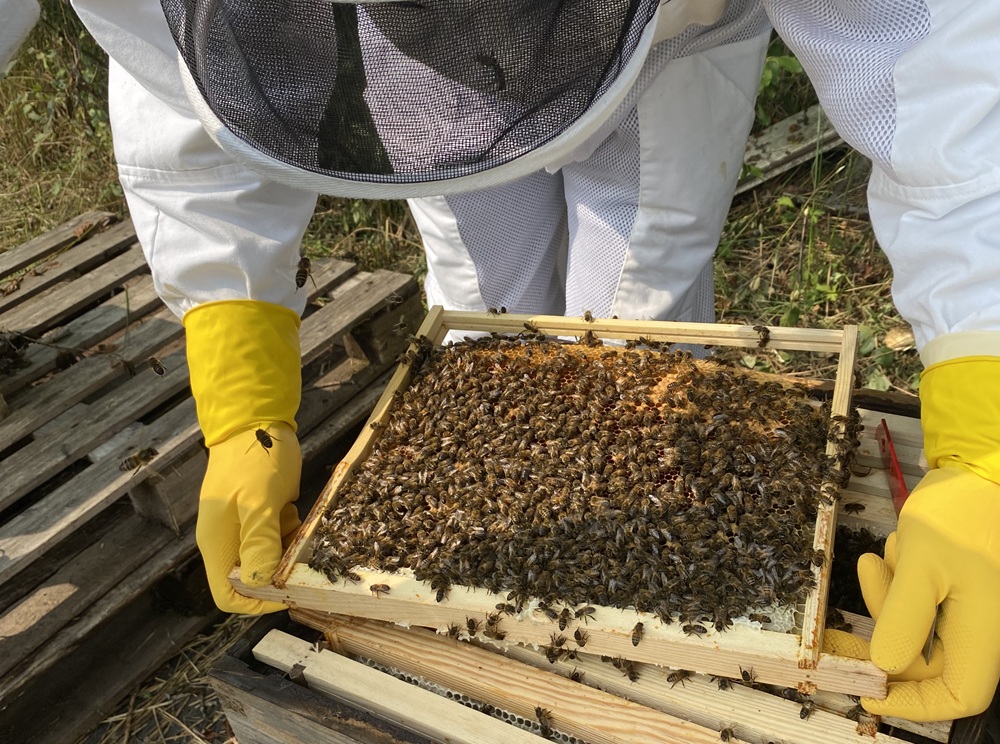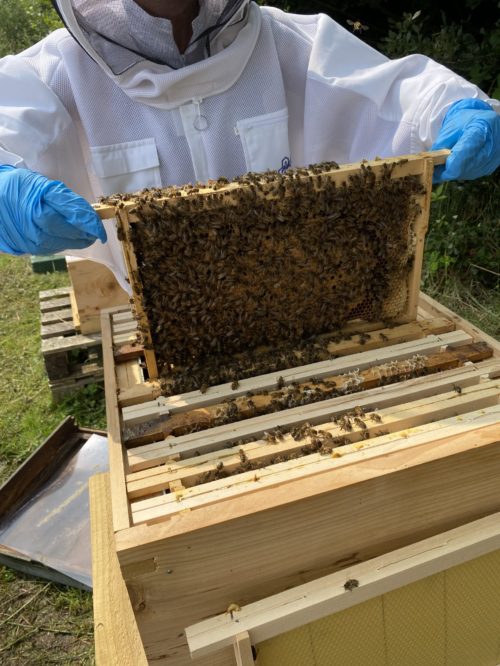The fight to save the native Welsh honeybee

Carwyn Graves
“Well over 99% of the honeybees we have now in Wales are not the pure native breed,” explains an experienced West Wales beekeeper to me on a wintery day in the countryside, “but I think preserving our native bees matters hugely – and I harvest tonnes of honey almost as a by-product of doing that work!”
The world of beekeeping – as in cheesemaking, orcharding or good stockmanship – is full of specialist knowledge and technical debates, which for the most part take place well away from the public eye. But often, as is the case with the ongoing discussions in the beekeeping community across Wales and the British Isles currently, they are of real public importance.
Because it turns out that the native honeybee – apis mellifera mellifera – is not only threatened in its remaining strongholds; it could also play a key role in our future for both nature and food production.
A native bee?
At a time when the potential health benefits of honey are receiving continued scientific interest, and up to 90% of the honey sold by major UK retailers is adulterated with glucose-fructose syrup, the future of good quality honey production is clearly a matter of wide interest. And given the well-documented collapse in honeybee populations over the past two decades, ensuring healthy bee populations that can produce this honey – and do much else besides – under adverse climatic conditions is an obvious challenge.
There are many types of bee in the world, with dozens of subspecies of honeybee alone. They are highly sociable creatures that excel at honey production and were first partly domesticated by us humans thousands of years ago. The different subspecies of honeybee naturally adapted, over time, to the prevailing conditions in their localities. In the case of the British Isles, the native bee – which is darker in colouring than many other honeybees – seems to have adapted in its behaviour to wet, chilly, long winters and to cloudier summers than their counterparts in more southerly climes. These ‘dark’ or ‘black’ native bees were the ones used here in beekeeping for hundreds if not thousands of years (a matter of debate).
But different subspecies of bee can interbreed, sharing their differing traits and characteristics. From the early twentieth century, new ‘improved’ breeds of bee were developed with the aim of ensuring greater productivity and strength, by crossing the native dark bee of southern England with Italian strains. These new bees were promoted, and over time became the dominant strains of honeybee – to the point where the native dark bee was more or less forgotten.
In a raincoat..
But as with many other things in food production – we’ve tried to go for productivity, but quite possibly at the expense of local adaptation and fitness for the climate. As Alison Fraser, Chair of the Carmarthen and District Beekeepers’ Association, explains to me, ‘we’ve had a situation where beginner beekeepers have been told repeatedly that the easiest route to success is via these new improved bees’ – and that has led to a cycle of dependence.
On a chilly winter’s day outside Carmarthen, my beekeeper friend explains how his populations of native bees are never fed over winter – in stark contrast to conventional practice with modern hybrid varieties. “You can think of them as Welsh bees, ok – they are happy to go out in a raincoat and wellies! They’re used to the wind and rain we have here. So on a spring morning, compared to an imported Italian bee, they will start flying earlier in the day – they don’t need to wait for it to warm up quite so much.”

Although overall less productive under ideal conditions and often claimed to be more prone to swarming (which beekeepers dislike), the native bee is clearly better adapted to pushing through and making the most of the landscape here, foraging well from native flowering plants. As the Beekeeper explains, the ideal site for his hives is one far from intensive agriculture or weedkillers, in a place with plenty of wildflowers of all sorts present. That makes these bees highly advantageous when it comes to conservation and widespread efforts to re-establish biodiversity.
But, as Alison explains, most new entrants into beekeeping are looking for a colony that they can easily source from a supplier, that will quickly produce honey for them and that they can then manage following instructions from a book or a Youtube video. All this is highly understandable – but has the unintended side-effect of introducing different strains and subspecies into an area, that may well be entirely unsuited to the prevailing conditions and are likely to hybridize with local native bee populations.
Survival
Spend any time with expert beekeepers and you come to appreciate the complexities of the topic and the depth of knowledge they carry – the sort of knowledge that can only be garnered by experience. What’s more, sharp differences of opinion exist, both between beekeepers and among different beekeeping bodies.
One of those bones of contention for many years was whether the native dark bee even survived – in Wales, Ireland or elsewhere in the UK, with different positions held depending on interpretation of the data. But both the BIBBA (Bee Improvement and Bee Breeders Association) and the Native Irish Honeybee Society have over recent years had success on the basis of published data and papers in persuading Governments in both Scotland and Ireland to pass legislation to protect and promote the native honeybee.
Though there is no specific legislation to this effect in Wales yet, it is clear to me from conversations with a number of individuals involved over the past two years that momentum is building to protect the native ‘Welsh dark’ honeybee here.
My Beekeeper friend started out in beekeeping decades ago, and like others who have had the benefit of close observation of many bee colonies, of running wide-ranging surveys and hands-on experience in beekeeping in Wales and other westerly parts of the British Isles, he’s clear that not only did populations of native bees survive but that they tended to do so in more isolated, westerly locations away from other populations, and that this is very much the case in Wales.
“It’s a constant effort”, Alison tells me. “We need to educate new entrants to beekeeping, support the work happening to conserve the colonies of native bees we do have and hopefully to stem the tide of those losses we saw
Support our Nation today
For the price of a cup of coffee a month you can help us create an independent, not-for-profit, national news service for the people of Wales, by the people of Wales.





Thanks very much for your interesting article, Carwyn.
I’m a honey aficionado (Aotearoa NZ manuka, white clover since birth) and taste honeys wherever I travel. Not to forget wines and cheeses..
However, your article did not indicate where it might be possible to obtain some of the Welsh native bee honey.
Some labelling looks ambiguous, though I might be doing their producers a disservice. Are you able to assist?